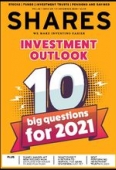Archived article
Please note that tax, investment, pension and ISA rules can change and the information and any views contained in this article may now be inaccurate.
This book can help you avoid potential stock disasters

There is no shortage of books on how to be a better investor – a fair selection of them have been reviewed by Shares – but there are precious few guides on how to spot corporate misdoing and save yourself from losing money when a company collapses.
Former AAA-rated New Star and Artemis fund manager Tim Steer has written the book we’ve all been waiting for: The Signs Were There: the clues for investors that a company is heading for a fall.
Bang up to date, the book singles out more than two dozen examples of companies where the writing was on the wall – or more accurately in the accounts – from the collapse of support services group Connaught in 2010 right up to the implosion of the Woodford Equity Income Fund.
START AT THE BACK
Steer’s first rule is to read a company’s accounts backwards, that is starting with the balance sheet, then progressing through the cash flow statement before finally considering the profit and loss (P&L) account. As he says, and as has been repeated many times, ‘cash is fact, everything else is a matter of opinion or an estimate’.
His second rule is to treat the accounts as an iceberg in terms of the information they contain. If there is anything in them which makes you feel uneasy or rings alarm bells, it’s highly likely there are ‘even more uncomfortable things lying below the metaphorical water line’.
Not all of the companies featured saw their share prices go to zero, but an awful lot did. Those that eventually got to grips with their problems and survived still lost investors large amounts of money.
When he says the signs ‘were there’, Steer backs it up with clear, easily understood examples of what investors should be looking for. In 23 of the companies featured, ‘there were clear signs in their annual reports that all was not well’, and in case of the other four companies their stock market listing prospectuses contained ‘items that should have raised a quizzical eyebrow or two’.
INTANGIBLE ASSETS
Often, companies which grow their earnings faster than the market eventually find themselves in a dilemma as growth slows. Do they disappoint investors and see their shares fall, or do they find creative ways to keep profits up and keep everyone happy?
Where a company is taking on lots of new business but doesn’t want to put the increased costs through the P&L, they can hide them on the balance sheet as intangible assets.
Although questionable, the practice is entirely legal under International Accounting Standard (IAS) 38 as long as the costs are part of a project which will produce ‘future economic benefits’.
Start-up costs on new projects, in-house software development costs, and research and development costs can be capitalised as assets and kept off the profit and loss account.
Connaught, cyber security group NCC (NCC) and Aston Martin Lagonda (AML) are all examples of companies which capitalised costs to flatter their earnings. At Connaught and NCC, these intangibles turned out to be worth a lot less than the companies had forecast and had to be written down.
INVENTORIES AND ASSET QUALITY
When it comes to inventories, also tucked away on the balance sheet, the collapse of Patisserie Holdings was a painful lesson in how what looked to be a highly profitable company was able to cook the books.
One warning sign was the lack of interest income considering the company claimed to have £29 million of cash. Sure enough, the cash wasn’t there, profits had been inflated and the company went into administration.
‘Channel stuffing’, or filling distributors’ forecourts with cars, was how Aston Martin boosted sales by 25% in 2018, the year it floated, but it also had to extend credit to the dealerships in order to carry it off.
As a result, ‘receivables’ – or revenues owed to the firm – and debt levels rose significantly. When sales started to disappoint, the twin effect of write-offs and interest costs punctured the share price.
SAVE YOURSELF MONEY
With good independent research hard for retail investors to source, and company presentations getting ever slicker, the annual report is the one document worth reading to check whether all is as it seems.
The case studies in the book are an excellent guide to what to look for, and by spending a little now investors could save themselves a great deal of money in the future.
Important information:
These articles are provided by Shares magazine which is published by AJ Bell Media, a part of AJ Bell. Shares is not written by AJ Bell.
Shares is provided for your general information and use and is not a personal recommendation to invest. It is not intended to be relied upon by you in making or not making any investment decisions. The investments referred to in these articles will not be suitable for all investors. If in doubt please seek appropriate independent financial advice.
Investors acting on the information in these articles do so at their own risk and AJ Bell Media and its staff do not accept liability for losses suffered by investors as a result of their investment decisions.
Issue contents
First-time Investor
Great Ideas
Great Ideas Update
Investment Trusts
Money Matters
News
- Surge in Airbnb and DoorDash stock renews tech bubble debate
- Marketing of high-risk mini-bonds banned from 2021
- Why aren’t investors cheering AstraZeneca’s bid for Alexion?
- Aberdeen Standard snares Tritax as logistics property boom continues
- Disney shares hit new record high on plans for major TV and film push
- Iron ore trumps gold as the hot commodity of 2020

 magazine
magazine










